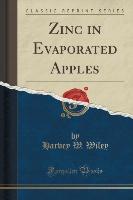Zinc in Evaporated Apples (Classic Reprint)
BücherAngebote / Angebote:
Excerpt from Zinc in Evaporated Apples
The development of the evaporated fruit industry in this country has rendered available for export large quantities of evaporated apples. By reason of the modern improvements in the methods of evaporation, the desiccated apples retain to a remarkable degree their freshness and flavor. After preparation for the table, the evaporated fruits are scarcely distinguishable from their fresh state either in color or taste.
In the last few years many objections have been made in foreign countries to the use of evaporated fruits on account of their contamination with zinc. By reason of the complaints made by exporters and consular agents, the Secretary of Agriculture authorized an investigation to be made for the purpose of determining whether evaporated apples contain zinc, and if so, whether in quantities prejudicial to health.
Investigations and Analyses Heretofore Made.
In beginning this investigation a search was first made in the literature of the subject to find out what had been accomplished in the matter heretofore, and to learn the methods of investigation and analysis employed.
In 1886 a large number of samples of evaporated apples was examined by Prof. S. A. Lattimore, of Rochester, N. Y., and the report of his work was published in the Sixth Annual Report of the State Board of Health of New York. The samples collected by Dr. Lattimore were dried on galvanized iron trays. At that time, he states, it was the custom of the manufacturers to sulphur the apples after they were sliced, so that the surface of the slices saturated with sulphurous acid was brought into direct contact with the galvanized iron during the process of drying.
No traces of zinc were found in the samples examined by Professor Lattimore, and this seems strange in view of the experience of our own and other analysts. Nevertheless, it was noticed that the galvanized iron wires suffered oxidation and lost zinc. In a given sample of the wire cloth used in making the bottoms of the trays, 33 per cent of its weight of zinc was found. In another sample of the same cloth, used for three years, only 9 per cent of zinc was found. This shows a loss of 24 per cent of zinc, which, it is explained, was caused principally by mechanical means.
About the Publisher
Forgotten Books publishes hundreds of thousands of rare and classic books. Find more at www.forgottenbooks.com
This book is a reproduction of an important historical work. Forgotten Books uses state-of-the-art technology to digitally reconstruct the work, preserving the original format whilst repairing imperfections present in the aged copy. In rare cases, an imperfection in the original, such as a blemish or missing page, may be replicated in our edition. We do, however, repair the vast majority of imperfections successfully, any imperfections that remain are intentionally left to preserve the state of such historical works.
Folgt in ca. 5 Arbeitstagen
